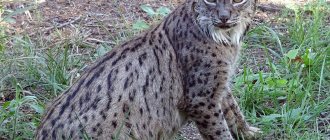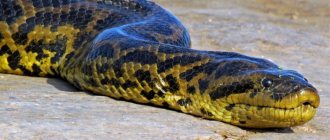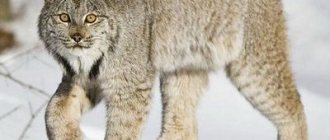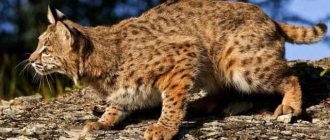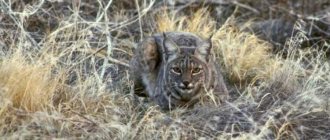The lynx is a solitary cat that frequents the remote boreal forests of North America, Europe and Asia. The lynx is covered with beautiful thick fur that keeps it warm in cold winters. Their large feet are also furry and hit the ground, making them natural snowshoes. No matter how beautiful this cat is, she is a predator. Can this animal be truly dangerous to human life?
Is lynx dangerous?
This animal poses no direct danger to humans. These cats are very secretive and prefer to avoid any meeting with humans. They hunt at night, so it is quite difficult to accidentally meet one in the forest.
There are several types of lynx. All lynxes are experienced hunters who use excellent hearing - ear tufts, their special natural hearing aid. Their vision is so strong that a lynx can spot a mouse at a distance of 75 meters.
The Canada lynx eats mice, squirrels and birds, but prefers hares. Lynx are so dependent on this prey that their populations fluctuate with periodic declines in the number of hares, which occur approximately every ten years. The larger Eurasian lynx hunts deer and other large prey in addition to small animals.
The Rachel Hightower Story
Attacks by lynxes in nurseries due to human negligence cannot be ruled out. Back in 2014, there was a sensational story about Rachel Hightower, who was attacked by a lynx. The victim's friend called 911 shortly after the attack. Rachel's friend told the 911 operator that his friend was attacked by a Siberian lynx and cut her head, which began to bleed heavily. The wounds were not serious and there was no need for stitches, but this situation greatly frightened the girl.
Lynx was one of several African Asian and American wild cats in a private cattery. Caretaker Dave Lowes said that he is the one who usually feeds the animals and with proper behavior with a predator, such situations are impossible. He also accused Rachel of making a fatal mistake, because she herself was the culprit of the lynx attack. She should not have entered the cage when feeding the animal, because for the lynx this is his personal safe territory. It was a very short incident.
Is lynx dangerous for humans?
The bobcat is not dangerous to humans, at least except in extreme or unusual circumstances, such as a rabid or cornered bobcat. The largest variety of lynx is the Eurasian lynx, where males can weigh up to 30 kg, which is quite a lot. The male Canada lynx only reaches a maximum of 10 kg, although many people insist that these cats can be much larger. There are even stories of 60-kilogram males, although experts do not believe such figures at all.
When hunting, these cats may look large through gun sights and binoculars, but their appearance is often deceiving because much of what humans see is just fluffy fur.
Even a 10 kg cat can cause harm to a person. But these animals are extremely secretive. Many people live around them their entire lives without even catching a glimpse of them. A lynx can cause pain to a person, although the possibility of being attacked by a lynx while simply being in the forest is so remote that it does not even merit serious consideration.
Messages 15
1 Topic by TuSku58 2017-04-26 12:22:26
- passerby
How dangerous is lynx for humans, and how can you protect yourself from it?
2 Reply from admin 2017-04-27 09:38:37
- Administrator
Is lynx dangerous? Of course it's dangerous. The lynx is an agile and strong predator the size of a large dog and weighing up to 35 kilograms. Of course, a lynx can injure and even kill a person, but I know of no cases where a lynx has killed a person. But there were cases of attacks on people. Most likely, in these cases, the lynx’s attack was the result of some kind of conflict situation, for example, the lynx had previously killed a guard dog, and soon a man appeared and began to drive the lynx away from his prey. There are frequent cases of collisions between humans and lynxes because lynxes are not very afraid of humans, they often hunt in the forests near villages, enter villages and even cities, and in hungry winters they can climb into the yard of a house to kill a dog or destroy a chicken coop.
If you encounter a lynx, try to quickly, but at the same time without sudden movements and without turning your back to it, move away from it to a safe distance or into shelter.
3 Reply from Kot Matroskin 2017-04-27 20:26:13
- Omich famous
- From: Omsk, Mayakovsky street
I remember last year there was news that in the Omsk region a lynx climbed into the yard of a private house and tried to attack the owner, who killed it with a shovel.
4 Reply from admin 2017-05-01 13:21:19
- Administrator
Yes, the incident happened in the Tevriz district in January 2016. According to a local resident, the lynx prepared to jump in his direction. Fearing for his life, the man hit the lynx with a shovel.
5 Reply from Justinnus 2017-05-13 15:06:55
- passerby
There is a story that a pack of mad lynxes was rampant in the north of Kazakhstan in the 70s. They attacked hunters, mushroom pickers, and lost people. They tore to death two dozen people, devoured their entire bodies, there were no bones left, only bloody, torn clothes were found, then they began to shoot them until they had killed everyone.
6 Reply from Scramadat 2017-05-16 10:39:38
- passerby
Invented to justify predatory hunting. With the connivance of the authorities, Kazakh and visiting poachers shot all the lynxes and then made up stories.
Preventing conflicts with lynx
What to do if you encounter a bobcat:
- Never approach an animal, especially if it is close to its prey or to a cat of the opposite sex.
- Never offer food to an animal.
- Always use caution if you approach a released or captive-bred bobcat.
- Never run from a lynx, because its instinct is to pursue its prey.
- If you are in a group, stay together and act as a group.
- Always face the animal and speak loudly while backing away slowly.
- Always leave room for the animal to escape.
- Don't crouch or try to hide, instead try to appear bigger.
- Don't take your eyes off the animal or turn away.
- If the animal does not run away, be more persistent: shout, wave your arms and throw something available at it.
Today we will talk about the lynx, another mysterious predator that can be extremely rarely found in the wild, even if you try hard. To answer the main question that we always consider, let's first get to know this predator better.
Lynx - a mysterious predator Lynx is a member of the cat family and is primarily known for its short tail and long tufts of dark hair on its ears and tufts.
There are 4 different subspecies of lynx: Canada lynx and bobcat, found in Canada and Alaska; common lynx, lives in almost all countries of Europe and Russia, Turkestan and Central Asia; as well as the Iberian lynx, the rarest lynx species that can only be found in Spain.
The lynx is covered with beautiful thick fur that keeps it warm during cold winters. Her large paws are very fluffy and when walking in the snow, thanks to the movement of her toes, she moves like on snowshoes.
These secretive cats avoid people and hunt at night, which is why they are rarely spotted. Typically, lynx that live in Europe, like their Asian relatives, are larger than their North American counterpart, the Canada lynx.
Photo. Morning stretches at the lynx
The bobcat is a professional hunter that uses its sense of hearing (the tufts on its ears are a hearing aid) and vision, allowing it to spot a mouse from 250 feet (75 meters) away.
The Canada lynx eats mice, squirrels and birds, but prefers the American hare. Lynx depend on this prey, which is why their numbers fluctuate with the number of these hares. The large common lynx, in addition to small animals, hunts deer and other large prey.
Lynx mate in early spring or late winter. After about two months, females give birth to one to four kittens. The kittens stay with their mother for up to nine months, which means she will look after them throughout their first winter. Later, grown-up lynx kittens leave their mother to live independently as adults. Adult lynx are known to give prey to their kittens to play with and develop their hunting skills, and then they eat it.
Although the lynx is not a very large mammal, it often climbs trees and swims to catch its prey. The lynx hunts small mammals, birds and fish, but prefers to hunt larger mammals like reindeer and elk, if, of course, the lynx can track and catch them.
The lynx has large paws, which help it balance and also give it more ability to pursue potential prey. The lynx also has strong jaws and sharp teeth that allow it to tear apart prey.
Photo. Steve Kroschel from the Kroschel Wildlife Center (Alaska, USA) with his beloved cat
Photo. In Steve's arms
Lynx are usually solitary and spend their time hunting or resting alone, but sometimes a small group of lynx can travel and hunt together.
The lynx lives in mountain crevices or under ledges, which provide the lynx with security as well as a home when kittens are born that need safe care. Lynx usually do not take their prey into the den, the only exception being when the female is looking after her kittens. Lynx cubs love to fight each other.
Video. Lynx. Raising a Predator
The lynx is a timid, cautious animal that usually stays away from human eyes. Even experienced hunters rarely see these majestic animals. While lynx will rarely attack people, all wild animals are unpredictable, so if you do see a lynx, exercise caution.
About lynx attacks on people All incidents involving attacks by wild animals on people arise for the following main reasons, which can be attributed to almost any animal:
1. A person has invaded the territory of an animal or is near its den; 2. The person found himself unacceptably close to the baby animals; 3. The person was the first to try to show aggression (human bravado); 4. A person accidentally stepped on an animal (snakes, scorpions, etc.); 5. The person violated safety rules in places where there are wild animals (zoos, parks, nature reserves).
As we see, all these reasons are caused by man himself, and as attack statistics report, in most cases of animal attacks on people, it is the people themselves, and not the animals, who are to blame. The exception to these reasons is when animals actually hunt people. We suggest getting acquainted with animals that hunt people. From this list we see that the lynx is not there, and this is understandable. Why?
In the world of predators, especially in the world of cats, size is very important, since a predator must always correctly assess its ability to kill a potential prey. If he does it wrong, he will either be killed, seriously injured, spend too much energy and end up with nothing, or still win, which is unlikely. A human is too big a prey for a lynx, and thanks to evolution, we really deserve not to be on the lynx’s list of potential victims. The lynx always avoids any meeting with a person and will not go into confrontation without a serious reason. But this does not mean at all that you should not beware of this formidable predator, which can still kill or seriously injure a person.
But it's also worth remembering that we humans are pretty weak animals for our size. Most animals of similar weight, and many that weigh significantly less, are much stronger than us. Not to mention the lynx's large tusks, strong jaws and razor-sharp claws, plus its speed, agility, and natural predatory instincts. Lynx can kill deer and elk, animals that are much more formidable than us in terms of size and strength in terms of weaponry.
But, nevertheless, we do not believe that a lynx is capable of attacking a person unless it is infected with rabies or is not protecting its young. They are generally shy animals that avoid people.
It is difficult to imagine circumstances under which a healthy lynx could engage in mortal combat with a human. The lynx searches and kills only those whom it intends to eat and unless a person arouses its hunting instincts.
Video. Lynx chasing a hare
Video. About lynx attacks on people
Known cases of lynx attacks on people December 2, 2014, USA, Atlanta. Investigators said the bobcat attacked a woman in the Buckhead area.
Police say the cat's owner was out of town and asked his friend to feed her while he was out. When she came to feed the cat, the lynx bit her on the head and caused cuts on her arms and back. The woman was treated at a local hospital. Police said her face was bleeding heavily and the animal was still in its cage after the attack.
According to a Department of Natural Resources official, the owner owned 9 cats, including 4 bobcats, one of which was a Canada cat, and 3 other cats of comparable size. Neighbors said this is not the first incident involving large cats.
The neighbors were nervous because they were not clear how the animal could attack the man hired to feed them. They reported that one of the big cats was previously able to roam around the area undisturbed.
Police found the injured man bleeding heavily from the head. A quadcopter arrived on site to check that the cats were safe and properly cared for. The owner of the cats had the appropriate permission to breed and keep animals.
June 12, 2016, Canada. A bobcat scratched a little girl on a ranch in Wainfleet. The child opened the plexiglass window in the lynx's enclosure, just enough for the lynx to reach out with its paw and scratch both sides of the girl's face. The girl stood there with her parents. Weland Humane Society executive director John Greer said the cat's claws were able to easily cut the skin and "that's the small amount of damage they can do in a very short period of time." The little girl is actually very lucky,” he said.
Surprisingly, that's all. And what can be concluded from these attacks? All recent lynx attacks on humans occur in captivity (not taking into account attacks by animals that were infected with rabies); little is known about similar attacks in the wild recently.
April 18, 2022, USA. Mike Popkowski, 70, of Connecticut, was at Mohegan Sun Golf Club in Sprague when he was attacked by a mad bobcat while playing golf. He reported that the lynx appeared out of nowhere, jumped on his back, bit his left arm and shoulder, and scratched his head.
He remembers little about the incident, but does remember a "guttural growl and a faint skunk odor" coming from the animal. At the hospital, he was treated for puncture wounds, a nearly severed earlobe and lacerations to his head that required 10 stitches. He has also completed a series of rabies vaccinations.
The lynx jumped from the high ground and eventually let him go. His friends believe the bobcat was on top of him for two or three minutes as they tried to fight it off with their golf clubs.
Photo. An American was attacked by a rabid lynx while playing golf.
Popkowski, who is retired from his job at the Naval Undersea Center, and three other men regularly play golf together three times a week. They started their round that day at 7 p.m., the bulletin said.
After the call came into the emergency dispatch center, conservation officers responded and interviewed witnesses at the golf course, Deputy Commissioner Susan Whalen said. They tracked paw prints in sand traps and found the bobcat fairly quickly. It turned out that the same lynx also attacked the horse that day. When she was killed and tested for rabies, the test came back positive.
How to avoid a lynx attack and save your life What to do if you encounter a lynx, which is extremely shy and rarely appears in front of people and how to prevent such conflicts.
If you encounter a lynx: never approach the animals, especially if they have killed prey or young animals nearby; never offer her food; Always use caution when approaching a captive-bred bobcat; do not trigger her hunting instinct to chase you - do not run away under any circumstances; if you are not alone, stay together and act as a single group; when confronted with an animal, speak to it firmly, slowly backing away; always leave an escape route for the animal; do not crouch and do not try to hide, but try to appear larger; do not take your eyes off the animal and do not turn your back; if the animal does not run away, be more persistent, shout, wave your arms and throw improvised means.
Video. Life of a wild cat. Lynx
How to avoid conflict with lynx: watch the landscaping of your home and garden, as this can attract deer and, consequently, lynx; burn all the foliage around your house; Watch for signs of animal activity, such as tracks, claws, and droppings; make noise when you walk through the forest: talk, sing, turn on the radio; Avoid areas frequented by animals, such as berry patches; travel in groups; if you went into the forest alone, tell someone where you plan to go and what time you plan to return; keep your dogs on a leash so that they do not provoke an attack by wild animals (it is better not to take them into the forest with you, the lynx will first try to attack them).
Bottom line: Lynx is undoubtedly capable of killing a person and such cases have occurred, but they are very rare, in most cases people survived or received lacerations. To prevent this from happening, you must adhere to the tips that we have outlined here.
This entry was published on Saturday, February 6, 2016 - 00:00. You can leave a comment.
How to avoid a lynx
- Avoid landscaping with plants that deer prefer. Where the deer goes, the lynx can follow.
- Light up all the paths around your home.
- Watch for signs of animal activity, such as tracks, claw marks, and droppings.
- Make noise while in the forest - talk, sing and listen to the radio.
- Avoid areas frequented by animals, such as berry groves.
- Travel in groups.
- Keep dogs on a leash to prevent them from provoking attacks from wild animals.
Lynx tend to live in isolated areas and avoid people as much as possible. The lynx is not particularly dangerous to humans, but people are very dangerous to it. Animals end up in traps for their valuable skins. The lynx's habitat is under threat from human encroachment and climate change. Like any animal, they are likely to be violent when wounded or cornered, but otherwise they pose no danger to humans.
Habitat
Most species roam high altitude forests, which provide good protection with dense bushes, trees, tall grass, large rocks and mountain gorges. Although this wild cat usually hunts on the ground, it is quite capable of climbing trees and swimming.
The Eurasian lynx lives in central and northern Europe, as well as in India, northern Pakistan and Iran near Mount Damavand. This species is most often found in northern European countries such as Norway, Finland and Sweden, as well as most of Russia.
The Iberian lynx is much less common and is found only in the southern parts of Spain. She also used to live in eastern Portugal, but is now virtually non-existent there.
The Canada lynx is primarily found in Canada and Alaska, but is also found in some northern US states such as Washington, Montana and Maine. Its habitat is mainly boreal forests, which are also known as snow forests and consist mainly of coniferous trees.
The red lynx spreads further than the Canadian lynx. It is found in southern Canada, much of the continental United States, and as far south as northern Mexico. It lives in both forests and meadows.
Kinds
Eurasian lynx
has long, thick, light fur, which becomes thick and long in winter, and shorter, thinner and darker in summer. It is the largest and most numerous species of lynx, as well as the most widespread species, currently found in 46 countries in Europe, Northern Asia and the Middle East!
Their favorite diet is deer and other ungulates. The Eurasian lynx, native to the Urals in Russia, follows the winter migration routes of roe deer, reindeer and moose.
The Eurasian lynx subspecies, the Siberian lynx, is the largest of all; some males can weigh up to 38 kg.
Spanish or Iberian lynx
The Spanish (or Iberian lynx) is the rarest of all wild cats, found only in Spain and Portugal. It is about half the size of the Eurasian lynx and has the most spots on its coat. Its coat is short and coarse for the milder Mediterranean climate.
She lives in an area where millions of migratory birds gather each spring and fall. Although rabbits form the mainstay of their diet, they also prey on ducks and other low-flying birds.
Canada lynx
native to Canada and the northern United States (including Alaska), also known as the North American lynx. It has very thick light brown or gray fur with light black spots. The North American lynx is approximately twice the size of a domestic cat.
Adult males are only slightly larger than females. Features unique to the Canada lynx include a black-tipped tail and huge paws with long, thick fur to keep the cat's toes warm in the winter. She can spread her toes wide, like snowshoes when walking on soft snow. Canada lynxes live in dense forests where their main prey are snowshoe hares.
Red Lynx
Found throughout North America, it is the most common native cat on our continent. But they don't have furry soles like other lynxes, so they're not as well suited to living in areas with heavy snowfall.
Lynx can survive in a variety of habitats, from deserts to swamps and forests, as long as there are places where they can hide. They often live in rocky areas, which shelter them from extreme cold or heat. They are good climbers!
